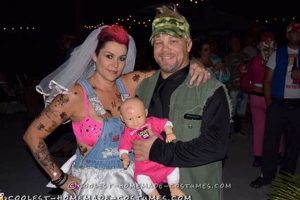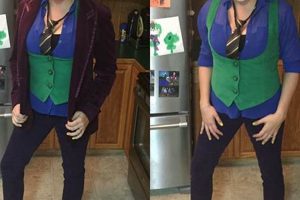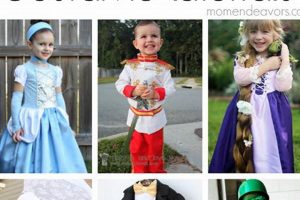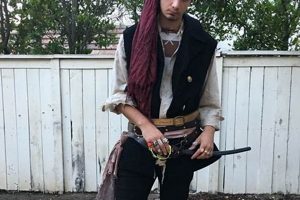A homemade crayon outfit represents a creative and cost-effective approach to dressing up for events like Halloween, school plays, or costume parties. Such an ensemble typically involves constructing a cylindrical or rectangular body piece, often from materials like cardboard or felt, and decorating it to resemble a crayon. A pointed hat, mimicking the crayon’s tip, frequently completes the look. For example, an individual might fashion a large tube from poster board, paint it a specific crayon color like red, and add a printed crayon brand label for authenticity.
The appeal of crafting this type of attire lies in its inherent customizability and affordability. It offers an opportunity to personalize the design with unique color schemes, embellishments, and sizes, catering to individual preferences and body types. Furthermore, constructing a crayon-themed garment from readily available materials can significantly reduce expenses compared to purchasing a pre-made costume. Historically, creating one’s own costumes has been a popular method for celebrations, emphasizing resourcefulness and personal expression.
Considering the inherent variability and potential for personalization, further discussion will focus on specific material selection, construction techniques, and design variations to achieve distinctive and impactful crayon-inspired looks. Subsequent sections will also address safety considerations and adaptable methods suitable for various age groups.
Crafting an Effective Crayon-Themed Garment
The following recommendations provide guidance on constructing a visually appealing and structurally sound crayon-themed garment.
Tip 1: Material Selection. Prioritize sturdy materials such as corrugated cardboard or thick felt to ensure the body piece maintains its shape. Lightweight options, like foam board, may necessitate internal reinforcement.
Tip 2: Accurate Color Matching. Utilize paint swatches or color charts to achieve precise color replication of the desired crayon shade. Consider employing fabric dye for felt materials to ensure uniform coloration.
Tip 3: Proportional Design. Adhere to realistic crayon dimensions when determining the costume’s size. Overly large or disproportionate designs may appear awkward or cumbersome.
Tip 4: Precise Label Replication. Employ graphic design software or stencils to accurately reproduce the crayon brand label and lettering. Pay meticulous attention to font style, size, and alignment.
Tip 5: Secure Fastening Systems. Implement robust fastening mechanisms, such as adjustable straps or Velcro closures, to ensure a secure and comfortable fit. Avoid relying solely on adhesive, which may weaken over time.
Tip 6: Ventilation Considerations. Integrate ventilation openings into the design, particularly if utilizing enclosed materials. This will mitigate overheating and enhance wearer comfort.
Tip 7: Durability Enhancement. Apply a protective sealant or coating to the finished product to prevent paint chipping, fabric fraying, and overall wear and tear. Consider a waterproof sealant if the garment will be used outdoors.
Adhering to these guidelines can significantly enhance the overall quality, durability, and visual impact of a homemade crayon-inspired ensemble.
With a strong foundation established, the subsequent section will delve into variations of crayon costume design, exploring creative adaptations and alternative construction methods.
1. Material selection
Material selection represents a foundational element in the creation of a homemade crayon outfit. The chosen materials directly impact the costume’s durability, visual appeal, comfort, and overall structural integrity. Inadequate material selection can result in a costume that is flimsy, uncomfortable, or visually unconvincing. Conversely, informed material selection can lead to a visually striking and long-lasting result. For example, opting for thin poster board may result in a collapsing crayon form, while utilizing corrugated cardboard provides significantly greater structural support.
The choice of materials is further influenced by factors such as budget, desired level of realism, and the wearer’s age and activity level. Fabric-based constructions, using materials such as felt or fleece, offer greater flexibility and comfort, particularly for young children. However, they may lack the rigidity necessary to convincingly replicate a crayon’s sharp edges and defined shape. Cardboard-based constructions offer greater structural integrity and lend themselves to more precise geometric forms, but can be less comfortable to wear for extended periods. Furthermore, the type of adhesive, paint, and decorative elements chosen must be compatible with the primary material to ensure proper adhesion and longevity.
In summary, deliberate and informed material selection is crucial for achieving a successful homemade crayon outfit. Careful consideration of material properties, budget constraints, and desired aesthetic outcomes will contribute significantly to the creation of a costume that is both visually appealing and functionally sound. Neglecting this critical aspect risks compromising the final product, resulting in a costume that fails to meet expectations in terms of appearance, durability, or comfort.
2. Color accuracy
Color accuracy stands as a pivotal factor in the recognition and effectiveness of a crayon-themed outfit. The visual impact of the costume relies heavily on the accurate replication of established crayon color palettes. Deviations from these expected hues can diminish the costume’s immediate recognizability and overall aesthetic appeal. For instance, a supposed “cerulean” crayon costume rendered in a shade closer to teal would lack the immediate association with the intended color and brand, thereby reducing the costume’s clarity.
The impact of color fidelity extends beyond mere aesthetics. In group costume scenarios, such as a classroom parade or a family theme, consistent color application is essential for a cohesive and visually impactful ensemble. Discrepancies in color can disrupt the overall visual harmony and detract from the intended effect. Moreover, accurate color reproduction reflects attention to detail, which communicates a higher level of craftsmanship and dedication to the costume’s creation. The importance of precise color-matching highlights the necessity of careful paint selection and fabric dyeing techniques.
In summation, the degree to which a homemade crayon garment effectively mimics the expected crayon colors directly influences its recognizability and visual impact. Achieving high color fidelity requires a diligent approach to color selection and application. Consequently, prioritizing accurate color representation is a crucial element in producing a successful and visually compelling costume, enhancing its overall effectiveness in
communicating the intended concept.
3. Construction method
The construction method employed in the creation of a crayon-themed garment dictates its structural integrity, visual accuracy, and overall feasibility. This element directly influences the costume’s ability to maintain its intended shape, withstand wear and tear, and effectively communicate the crayon concept. For instance, a haphazardly assembled costume utilizing insufficient adhesive or unstable support structures will likely deform or collapse, rendering it unrecognizable as a crayon. Conversely, a well-engineered design, incorporating sturdy materials and precise assembly techniques, results in a durable and visually convincing representation. The choice between a simple cylindrical structure, a multi-faceted design mimicking a crayon box, or even a wearable crayon tip shape necessitates distinct construction approaches and material considerations.
Varied construction methods cater to differing skill levels, available resources, and desired levels of realism. For example, a beginner might opt for a straightforward approach involving wrapping cardboard around the wearer and securing it with tape, while an experienced crafter could utilize pattern-making techniques to create a form-fitting fabric garment with integrated structural supports. Furthermore, the construction method affects the costume’s practicality. A bulky, rigid structure may impede movement and comfort, whereas a lighter, more flexible design allows for greater mobility. Real-world examples, such as costumes seen at Halloween parades, frequently demonstrate the direct correlation between construction method and the final product’s success.
In conclusion, the selection and execution of an appropriate construction method are fundamental to the successful creation of a crayon costume. This element dictates the costume’s appearance, durability, and wearer comfort, directly impacting its overall effectiveness. Understanding the interplay between design choices and construction techniques is crucial for achieving a visually appealing and structurally sound crayon-themed ensemble. Failing to consider this integral aspect can result in a costume that falls short of its intended purpose.
4. Design creativity
Design creativity serves as the driving force behind the successful execution of a homemade crayon-themed outfit. It extends beyond mere replication of a crayon’s basic form, encompassing imaginative interpretations and personalized embellishments that elevate the costume from a simple craft project to a distinctive expression of individual style.
- Adaptation of Crayon Style
Design creativity facilitates adaptation of crayon aesthetics to suit various body types and age groups. Rather than a uniform cylindrical form, designs can incorporate A-line silhouettes for greater comfort or utilize separate top and bottom pieces for increased mobility. For example, a child’s costume might feature a shorter, wider form for ease of movement, while an adult’s costume could adopt a more elongated and streamlined shape. These adjustments require creative problem-solving to maintain the crayon’s essential visual cues while accommodating practical considerations.
- Incorporation of Unique Embellishments
Creative design enables the integration of unique embellishments that enhance the costume’s visual appeal and personality. Beyond standard crayon brand labels, individuals might incorporate hand-painted designs, glitter accents, or even small-scale props such as miniature crayon boxes or paintbrushes. These additions inject individuality into the costume, distinguishing it from generic store-bought alternatives and reflecting the wearer’s personal style. An example would be a costume incorporating a “melted crayon” effect achieved through strategically placed fabric drips, adding a playful and unexpected visual element.
- Material Exploration and Innovation
Design creativity fosters experimentation with unconventional materials and techniques. Instead of relying solely on cardboard or felt, individuals might explore alternative materials such as recycled plastics, foam sheets, or even inflatable structures to achieve unique visual effects or structural properties. This material exploration not only enhances the costume’s visual distinctiveness but also promotes sustainability by repurposing discarded materials. An example could be a costume constructed from repurposed plastic bottles, carefully arranged and painted to mimic the texture and appearance of a crayon.
- Thematic Integration and Narrative Elements
Creative design allows the incorporation of thematic integration and narrative elements that extend the costume beyond a simple crayon representation. For instance, a costume could depict a “zombie crayon” with tattered edges and smeared paint, adding a horror-themed twist. Alternatively, a costume could represent a “superhero crayon” complete with a cape and mask, combining two distinct themes into a cohesive and imaginative design. These narrative integrations elevate the costume from a static representation to a dynamic expression of creativity and storytelling.
These facets of design ingenuity converge to elevate a homemade crayon outfit beyond mere imitation. By creatively adapting the form, incorporating unique embellishments, exploring unconventional materials, and integrating thematic elements, individuals can transform a simple concept into a compelling and personalized expression of artistry. The limit on how expressive these can be remains only to how creative one can become.
5. Wearer comfort
Wearer comfort is a paramount consideration in the successful creation and implementation of a homemade crayon outfit. A visually appealing costume that compromises the wearer’s comfort is ultimately impractical and detracts from the overall experience. The following details outline key facets of wearer comfort and their implications for the design and construction of a crayon-themed garment.
- Material Breathability and Skin Irritation
Material selection directly impacts breathability and the potential for skin irritation. Enclosed costumes constructed from non-breathable materials like plastic or non-porous cardboard can trap heat and moisture, leading to discomfort and potential overheating. Similarly, materials with rough textures or chemical treatments can cause skin irritation. The careful selection of breathable fabrics, such as cotton or linen, or the incorporation of ventilation openings is crucial for mitigating these issues. An example would be lining the inside of a cardboard costume with a soft, moisture-wicking fabric to prevent chafing and promote airflow.
- Range of Motion and Mobility Restriction
The costume’s design and construction method influence the wearer’s range of motion and overall mobility. Restrictive designs that limit arm movement, leg flexion, or head rotation can be cumbersome and impede participation in activities. Overly tight or inflexible materials can further exacerbate these limitations. Prioritizing a design that allows for a reasonable ra
nge of motion is essential. For example, incorporating flexible joints or adjustable straps can improve mobility without compromising the costume’s visual integrity. Costumes seen at parades often need large arm holes for waving and interacting with the crowd. - Weight and Balance Distribution
The weight and balance distribution of the costume significantly impacts wearer comfort, particularly for extended periods of use. Uneven weight distribution can strain specific muscle groups, leading to fatigue and discomfort. Overly heavy costumes can be burdensome and increase the risk of tripping or falling. Employing lightweight materials and distributing the weight evenly across the body are crucial for mitigating these issues. For example, utilizing lightweight foam board instead of heavy cardboard and incorporating shoulder straps or a harness system can improve weight distribution and reduce strain.
- Accessibility and Ease of Donning/Doffing
The ease with which the costume can be put on and taken off directly affects wearer convenience and comfort. Complicated or restrictive entry and exit methods can be frustrating and time-consuming, particularly for young children or individuals with limited mobility. Implementing simple and accessible fastening mechanisms, such as Velcro closures or adjustable straps, is essential for facilitating easy donning and doffing. Consider a design that allows the wearer to easily remove the costume independently, especially in situations requiring quick changes or restroom breaks.
These facets highlight the critical interplay between design choices and wearer comfort in the creation of a successful homemade crayon outfit. Prioritizing these elements ensures that the costume is not only visually appealing but also practical and enjoyable to wear. A costume that effectively balances aesthetics with comfort is more likely to be worn with enthusiasm and contribute positively to the overall experience. Poorly designed costumes can lead to discomfort and overall dissatisfaction.
6. Cost effectiveness
The economic feasibility of creating a homemade crayon outfit is a primary motivator for many individuals. Cost-effectiveness, in this context, refers to the ability to produce a visually appealing and functional costume using readily available, inexpensive materials and straightforward construction techniques, thereby minimizing overall expenditure.
- Material Sourcing and Repurposing
A key aspect of cost-effectiveness lies in the strategic sourcing and repurposing of materials. Instead of purchasing new fabrics or construction materials, individuals often utilize items already present in the household, such as cardboard boxes, discarded fabric scraps, or old clothing. This approach reduces material costs significantly and promotes resourcefulness. For example, an old bedsheet can be dyed and repurposed as the main body of the crayon costume, eliminating the need to purchase new fabric. Further cost reduction can be achieved by utilizing discarded wrapping paper or felt scraps for the crayon label and detailing.
- Simplified Design and Construction
Another factor contributing to cost-effectiveness is the adoption of simplified design and construction methods. Elaborate designs requiring specialized materials or advanced sewing skills increase both material costs and labor time. Conversely, a simple cylindrical design constructed from readily available materials like cardboard and secured with basic adhesives minimizes both material expenditure and construction complexity. An example of this approach is creating a crayon costume by wrapping a child in cardboard, painting it a solid color, and adding a hand-drawn label. This eliminates the need for complex pattern-making and sewing.
- Minimizing Specialized Equipment and Tools
The requirement for specialized equipment and tools can significantly impact the overall cost of costume creation. Projects requiring sewing machines, specialized cutting tools, or expensive paints increase the initial investment. Cost-effective approaches prioritize the use of common household tools, such as scissors, glue, and readily available paints. For example, instead of using a sewing machine to create a fabric costume, an individual can use fabric glue to assemble the garment. Similarly, acrylic paints, readily available at most craft stores, can be used instead of more expensive specialty paints.
- Long-Term Value and Reusability
The potential for long-term value and reusability contributes to the overall cost-effectiveness of the costume. A well-constructed costume made from durable materials can be reused for multiple events or passed down to other individuals. This extends the value of the initial investment and reduces the need for future costume purchases. For example, a crayon costume constructed from sturdy cardboard and coated with a protective sealant can be reused for multiple Halloween celebrations or school events. Furthermore, the costume can be easily modified or adapted to represent different crayon colors or brands, further extending its lifespan.
These factors highlight the connection between economic considerations and the creation of crayon-themed garments. By leveraging resourcefulness, simplifying designs, minimizing specialized equipment, and maximizing long-term value, individuals can create visually appealing and functional costumes without incurring significant expenses. This demonstrates the viability of creating homemade crayon outfits and ensures a more cost-effective outcome.
Frequently Asked Questions
The following questions address common inquiries regarding the design, construction, and practicality of crayon-themed outfits.
Question 1: What materials are most suitable for constructing the body of the costume?
Corrugated cardboard and thick felt offer robust and visually appealing options. Corrugated cardboard provides structural integrity, while thick felt offers flexibility and comfort. Material selection should consider desired durability, cost constraints, and wearer comfort.
Question 2: How can accurate color replication of a specific crayon shade be achieved?
Utilizing paint swatches or color charts from reputable paint manufacturers is advisable. Matching the chosen paint or fabric dye to a known crayon color ensures visual accuracy and enhances recognition. Direct comparison of the chosen color against a physical crayon sample is recommended.
Question 3: What is the best method for attaching the crayon label to the costume?
Adhesive spray or fabric glue provides a secure and durable bond. Sewing the label onto fabric-based costumes is also a viable option. The choice depends on the costume’s primary material and desired level of permanence. Ensure the adhesive is compatible with both the label and the costume material.
Question 4: How can wearer comfort be maximized, particularly for extended periods of use?
Selecting breathable materials, ensuring adequate ventilation, and avoiding overly restrictive designs are crucial. Lining the interior of the costume with a soft fabric, such as cotton, can minimize skin irritation. Proper sizing and weight distribution are essential for comfort and mobility.
Question 5: What safety precautions should be taken during construction and use of the costume?
Non-toxic paints and adhesives should be used to minimize potential
health risks. Sharp edges and protruding components should be avoided to prevent injuries. Adequate visibility must be ensured to prevent accidents. Adult supervision is recommended, especially for costumes worn by children.
Question 6: How can the costume be adapted to accommodate different age groups and body types?
Adjustable straps, flexible materials, and modular designs allow for customization. Smaller costumes can be created for children, while larger, more accommodating designs can be used for adults. Consider the wearer’s specific needs and limitations when adapting the design.
These FAQs provide guidance on common concerns related to crayon-themed garments. Adhering to these recommendations contributes to a safer, more comfortable, and visually appealing result.
The subsequent section will address various design variations and alternative construction methods for crayon-inspired attire.
Conclusion
This exploration has presented a comprehensive overview of crafting a crayon-themed garment, underscoring the importance of strategic material selection, accurate color replication, sound construction methodologies, creative design implementation, wearer comfort considerations, and principles of cost-effectiveness. Adherence to these elements contributes significantly to the creation of a visually impactful, durable, and practical result. The exploration also addressed common concerns via a series of frequently asked questions, providing clarity on critical aspects of the design and construction process.
The creation of a crayon-themed attire, whether for celebratory occasions or artistic expression, provides a unique opportunity to demonstrate ingenuity and craftsmanship. Continued focus on optimizing design and construction techniques, coupled with an emphasis on safety and user experience, ensures ongoing advancements in this realm. The impact of these creations, when well executed, transcends mere aesthetics, fostering individual expression and contributing to the visual landscape of celebratory events. Further innovation in materials and techniques will undoubtedly shape the future of this art form.







